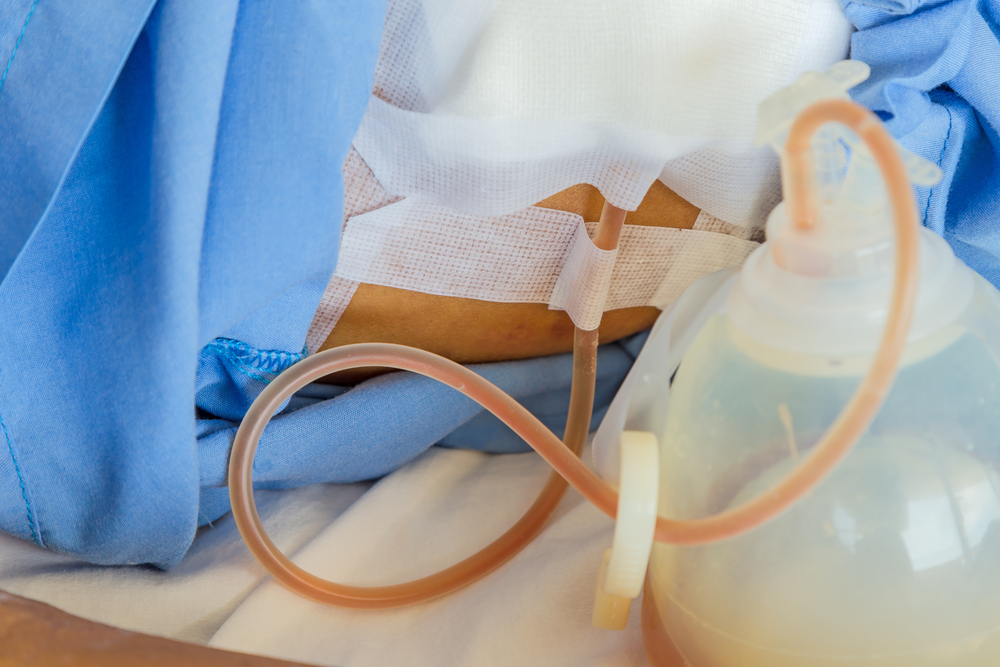- The tummy tuck is a great surgical procedure for removing excess skin, stretch marks, and fat, but certain post-op devices and techniques are required for proper healing.
- One of these is the tummy tuck drain, a small tube with a bulb attached that allows you to remove excess fluid to prevent seroma, infection, and other complications.
- Understanding proper surgical drain care is an important part of the recovery process that will help you get back to your normal activities faster.
- A newer tummy tuck procedure that eliminates the need for drains, dubbed the “no-drain tummy tuck”, is gaining steam in the cosmetic surgery world.
If you’ve been researching different kinds of tummy tucks (abdominoplasty), you’ve probably come across the no-drain tummy tuck and the standard tummy tuck. For those who have never had cosmetic surgery before, often just the word “drain” can be a major turn-off.
But these devices aren’t as scary as they seem. In fact, in most cases, they’re integral to a proper post-op plan and help speed up recovery times so you can be back to your best self and proud to show off your flat, new tummy in no time.
We examined the in’s and out’s — quite literally — of tummy tuck drains, including what and how long they’re used for, how they affect healing, and whether you should opt for a no-drain procedure instead of the standard method
If you take one thing away from this information, it’s that surgical drains should never deter you from seeking tummy tuck surgery. Remember, the drains are short-term, but your results are permanent.
What Are Tummy Tuck Drains?
Let’s get down to the drain basics. Following surgery, fluid — typically serous fluid composed of blood plasma from ruptured blood vessels and inflammatory fluid produced by injured cells — tends to build up in the area between the skin and muscle, known as “dead space”.
This space is to blame for the fluid collection that triggers seromas, so in a traditional tummy tuck, steps must be taken to remove fluid accumulation from that area. A tube placed in the soft tissue tunnel extends to the dead space, allowing you to flush away the fluid.
At the end of your tummy tuck procedure your plastic surgeon inserts the drains — usually clear tubes made of silicone — through a short incision behind the primary incision. In most cases, the drains extend from either a small gap in the lower abdominal incision or the large surface area between the pubic region and ribcage. The tube then leads out of your body into a small bulb about the size of a lemon. Periodically, fluid accumulation must be emptied by squeezing the bulb, which creates a gentle suction that pulls fluid from the body.
Why Drains Are Used
The primary job of these drainage tubes is to reduce serous fluid accumulation at the site of the incision and treatment area, which helps to reduce complications associated with the tummy tuck procedure.
The drain site also helps prevent post-surgical seromas, collections of lymph fluid that can develop beneath the surface of the abdominal skin following surgery. Seromas can lead to serious complications, including infection, fever, pain, swelling, and bloody drainage.
Such drain tubes also have a secondary purpose. They help your doctor measure how your body is recovering after cosmetic surgery by allowing him or her to draw conclusions based on the amount of bleeding and fluid buildup within your lower abdomen.
For example, if you notice a large amount of fluid coming from your navel, this may indicate irritation caused by the sutures in the abdominal wall. A good, board-certified plastic surgeon will be able to draw conclusions based on this fluid to facilitate a safe, speedy recovery.
Usually, drain removal occurs once your surgeon identifies that your body is no longer producing extra fluid. When the color of the fluid appears normal and is low and consistent (roughly 30 milliliters of drainage over 24 hours) it’s usually safe to remove the drains.
How long tummy tuck drains need to be used varies from person to person. Most surgeons say they usually remove the final drain within one week, but sometimes patients need to keep them in for as long as two weeks.
How to Empty and Clean Tummy Tuck Drains
Any good plastic surgeon will provide you with proper drain care instructions in advance of your procedure. And for the best results, it’s always important to closely follow their directions.
In general, you’ll need to empty the bulb a few times a day until you’ve fully healed or your doctor believes it’s safe to remove the drain. It’s important to understand exactly how, and how often, to drain the fluid, as well as how best to keep your drains clean to prevent infection.
First, use one hand to grasp the drain near where it meets the skin. Use the other hand to pinch the drain, pushing the fluid toward the bulb. Once the bulb is filled with fluid, squeeze it to create negative pressure. When the bulb is about halfway full, you can empty it into the toilet.
Make sure to take note of how much fluid is present before emptying the bulb (it will usually have built-in measurement lines) and write it down. Your surgeon will request a drain log reporting how much fluid was drained along with the date and time.
You should also make sure to regularly clean the part of the drain that’s outside of your body to ensure no bacteria builds up and causes an infection. Always wash your hands when handling the drain or the bulb — or any of your tummy tuck recovery bandages or dressings, for that matter — to prevent transferring bacteria.
You should also apply antibiotic ointment to the area where the drain meets the skin to prevent any potential infections from occuring.
Showering and Everyday Life with Drains
Post-procedure bathing can be a challenge in and of itself, and things get even more complicated when you’re dealing with drains. In general, just make sure to take gentle showers or sponge baths during recovery to prevent irritating your drains, sutures, or incisions.
Your doctor will probably recommend avoiding perfumed soaps, old sponges and washcloths, and sticking to antibacterial soaps and washing yourself with your hands in order to prevent the accumulation of bacteria.
When you shower, make sure your drain tubes don’t get moved or manipulated by the pressure of the water or your movement. To prevent this, you might want to consider using waterproof gauze or purchasing a waterproof drain belt to keep the drains and bulb in place.
The best course of action is to ask your plastic surgeon how he or she recommends you shower during your recovery period.
Keeping Them Protected and Discreet
The average time before drain removal varies from patient to patient, but some people are able to go on with their normal, daily activities with their drains still in use. Because of this, it’s important to develop a strategy that will keep your drains protected and discreet while you’re at work, running errands, at the gym, or even just visiting with friends post-procedure. Protecting your drains will facilitate healing by keeping them safe and protected from pulls.
There are a variety of products sold specifically for the purpose of hiding tummy tuck drains. Among them are post-surgical drain belts in stylish, waterproof fabrics that enable you to wear your bulb outside your body without drawing attention.
Some companies even make special recovery robes that feature pockets for your drains and bulb. Your doctor may also recommend the use of abdominal binders or compression garments to keep the drains securely in place and protected throughout the recovery period.
Addressing Common Issues
What happens if the drain is removed too soon? If your tummy tuck drain starts coming out before your doctor officially removes it, the first thing you need to do is call him or her right away. Your surgeon always needs to be aware of your situation.
Should your drain come out too soon for any reason, there’s an excellent chance your surgeon will recommend regular in-office draining (typically through a needle) and the wearing of a compression garment to prevent seromas.
What should you do if your tummy tuck drain gets clogged? Unfortunately, this is a reality for some people who need to wear surgical drains for extended periods.
If a drain gets clogged, the tubes won’t effectively remove the fluid buildup, which can cause serious complications. The best course of action is to call your plastic surgeon and schedule an exam to ensure that the drain is indeed clogged, and if it is, he or she will return it to proper working condition.
Heal your tummy tuck scars completely with these products.
Try out these products to help control your tummy and flaunt your curves.
OWAYS Slimming Belt
This Slimming Belt is an effective way to help you lose weight without going to the gym by providing an oscillating massage with mild heat. Help you keep your muscles strong and flexible, and also relieve stress.
SHAPERX Shapewear for Women
It is designed to accentuate your natural curves by shaping the abdomen with targeted firm double tummy control. It is ideal for any occasion where you want to flaunt your lovely curves.
M3 Naturals Anti Cellulite Massage Oil
The blend of natural ingredients will help you remove cellulite from your hips, abdomen, thighs, and buttocks by moisturizing, tightening, and toning with regenerating benefits.
Slimming Weight Loss Cream
Double weight reduction with herbal extracts by stimulating fat burning, boosting metabolism, and helping you lose weight. Get rid of cellulite and achieve the slimming look you’ve always wanted!
Abdominal Binder Post Surgery Compression Wrap
This compression belly band is super comfortable and soft; it helps improve blood circulation, reduce swelling, and remove potentially hazardous fluids from the body post-surgery.
IMPRESA Lipo Foam
The post-surgery foam pads will provide you with total compression over the healing area and assist in the even distribution of pressure for increased comfort and healing.
The Skinny on No-Drain Tummy Tucks
If all of this sounds a bit too gruesome for you, there is an alternative: the no-drain tummy tuck. Remember the “dead space” we mentioned earlier? With no-drain tummy tucks, plastic surgeons use progressive tension sutures to sew up this potential space so fluid is less likely to accumulate.
Essentially, surgeons use the sutures to better and more evenly stretch the skin over the muscles, largely eliminating any space where fluid can build up.
The small amount of fluid that does accumulate is easily absorbed by the body. Most plastic surgeons agree that even after traditional drains are removed, fluid still accumulates, so any little bit that might accumulate after a no-drain tummy tuck poses no greater risk.
That being said, many experts have been slow to fully back the no-drain method. Nevertheless, it clearly has it’s benefits, and many trusted, board-certified plastic surgeons prefer it over the alternative. So it’s definitely worth a conversation with your surgeon — especially if you’re somebody who finds the traditional tummy tuck drain method just a little too gross for your liking.















